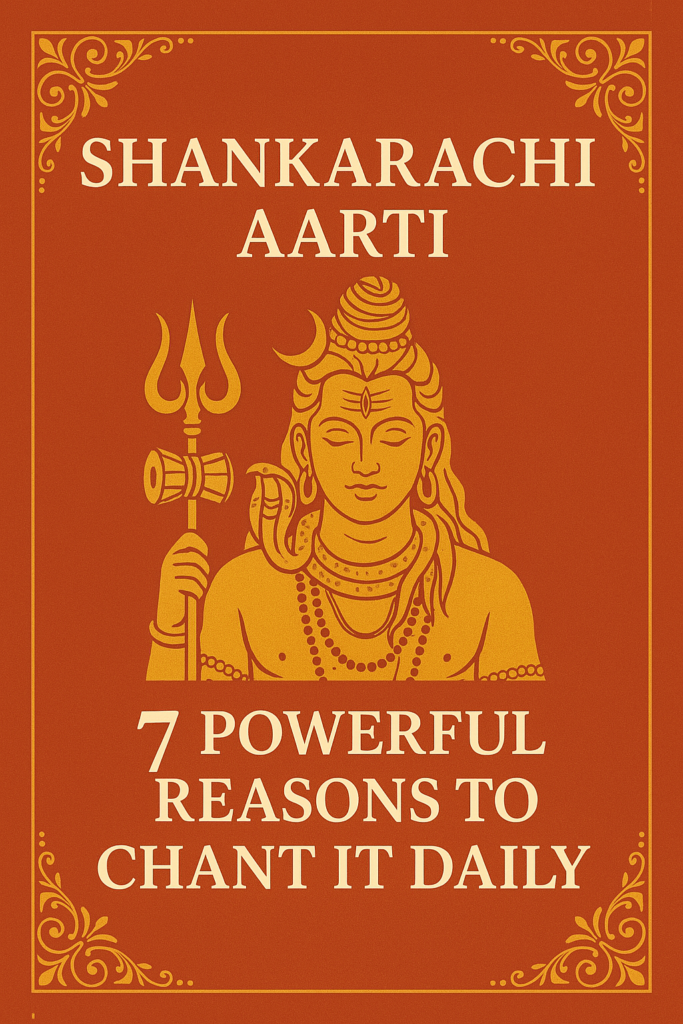India’s spiritual heritage is a living, breathing river of devotion, and at its heart lies the timeless “Shankarachi Aarti.” This sacred hymn, dedicated to Lord Shankar (Shiva), resonates through temples and households, especially in Maharashtra, as devotees sing it in the glow of flickering oil lamps. It isn’t just a song—it’s a heartfelt conversation with the divine, filled with reverence, symbolism, and intense spiritual energy.
At first glance, “Shankarachi Aarti” may seem like just another Marathi devotional composition, but once you delve into its meaning, something magical happens. You feel peace settle in. Your mind stills. Your heart opens. In this article, we explore the profound significance, historical origins, and benefits of chanting the Aarti daily. We’ll also break down its poetic beauty, cultural essence, and transformative spiritual power.
What is Shankarachi Aarti?
“Shankarachi Aarti” is a Marathi devotional song composed in praise of Lord Shiva, also revered as Shankar or Mahadev. Traditionally sung during puja (worship) rituals, this Aarti expresses gratitude, invokes blessings, and reinforces the presence of the divine in daily life.
Unlike longer hymns like the Rudram or Shiva Tandava Stotram, this Aarti is concise yet powerfully evocative. It is especially popular on Mondays (considered auspicious for Shiva) and during festivals like Mahashivratri.
Origin and History of Shankarachi Aarti
While the exact author remains unknown, oral traditions suggest that this Aarti emerged during the Bhakti movement in Maharashtra. The region has given birth to saint-poets like Sant Tukaram and Sant Ramdas, who composed numerous devotional hymns.
This Aarti mirrors the same spirit—simple language, heartfelt devotion, and an invitation to immerse in bhakti (devotion). The text has been preserved for generations, taught from parent to child, passed through musical evenings, and etched in the collective memory of devotees.
Meaning and Significance of the Lyrics
Each line of Shankarachi Aarti is a poetic gem:
-
“Jai dev, Jai dev, Shankar Jai dev”
This salutation repeats the glory of Lord Shankar, invoking Him with joy and reverence. -
“Tripurantak Pahije Avaghad Mi”
Refers to Shiva as the destroyer of evil (Tripurantaka), showing His immense power over darkness. -
“Daya kar, Daya kar, Daya kar mazyavari”
A humble plea for divine grace—one of the most repeated themes in Marathi devotion.
The repetition, rhyme, and rhythmic structure make the Aarti easy to memorize and emotionally engaging.
Why Chant Shankarachi Aarti Daily?
Invokes Peace and Positivity
Chanting devotional verses regularly stabilizes the mind. The vibrations generated from this Aarti are known to calm the nervous system and create a serene atmosphere.
Strengthens Spiritual Discipline
Daily repetition cultivates a sense of routine in your spiritual practice. Even a few minutes each day can anchor your thoughts and foster mindfulness.
Purifies the Home Environment
The sacred sound waves purify not just the chanter but also the surrounding space. Many households chant the Aarti during Sandhya (evening prayer) to dispel negativity.
The Musical Beauty of Shankarachi Aarti
Set traditionally in Raag Bhairavi or Raag Yaman, the Aarti’s melody carries both joy and solemnity. Instruments like the harmonium, tabla, and cymbals add a festive yet sacred flavor, turning the chant into a soulful offering.
Its simplicity makes it accessible to children and elders alike. Whether sung solo or in a group, it unites voices and hearts.
Symbolism in Shankarachi Aarti
Every element in the Aarti paints a divine portrait:
-
“Trinetra” dhari”—Shiva’s third eye symbolizes wisdom beyond duality.
-
“Jatadhari”—His” matted locks signify renunciation.
-
“Gangadhari”—The” river Ganga, flowing from His hair, represents purification.
Each name, each phrase opens a spiritual door.
When to Chant Shankarachi Aarti?
-
Monday evenings (most ideal)
-
During Mahashivratri
-
After completing a Rudrabhishek
-
Before bedtime for a peaceful sleep
-
At the start of any auspicious occasion
While there’s no wrong time, consistency amplifies the spiritual effect.
Shankarachi Aarti in Festivals and Temples
During Mahashivratri, the Aarti echoes across temple courtyards, often sung multiple times throughout the night. Devotees offer belpatra, rudraksha, and milk while singing, transforming the atmosphere into one of divine celebration.
In temples like Trimbakeshwar and Bhimashankar, thousands of devotees join together for the Aarti—a spiritual spectacle one must witness.
Scientific Perspective on Chanting
Modern science backs ancient wisdom: rhythmic chanting influences the brain. Studies show that mantra recitation:
-
Reduces cortisol (stress hormone)
-
Increases alpha waves (calm alertness)
-
Enhances concentration
The repetitive nature of Shankarachi Aarti serves as a form of vocal meditation.
Also read: Kirtan Sohila: 5 Profound Truths of Sikh Bedtime Prayer
How to Prepare for Chanting Shankarachi Aarti
-
Light a diya or incense to purify the space
-
Sit facing east if possible
-
Focus on Lord Shiva’s image or lingam
-
Chant with full attention and emotion
No need for perfect pitch—devotion matters more than vocal ability.
Simple Rituals to Enhance the Experience
-
Sprinkle Ganga jal in your home
-
Offer white flowers or bael leaves
-
Keep a rudraksha mala nearby
-
Maintain silence for a few moments after chanting
These small gestures deepen your connection.
Conclusion
In a fast-paced world flooded with distractions, the Shankarachi Aarti offers a spiritual anchor. It asks for nothing but your voice and your heart. You don’t need expensive rituals or elaborate temples. All you need is the will to connect.
With regular chanting, this humble Aarti becomes a lifelong companion—whispering strength during challenges, joy during celebrations, and peace during solitude. Let it echo through your life, just as it has in countless homes for centuries.
FAQs
What is the best time to chant Shankarachi Aarti?
The most powerful time is Monday evenings or during Brahma Muhurta (early morning), but it can be recited anytime with devotion.
Is Shankarachi Aarti suitable for beginners?
Yes. It’s short, easy to learn, and deeply meaningful—perfect for those starting their spiritual journey.
Can I chant Shankarachi Aarti without knowing Marathi?
Absolutely! Many online resources provide translations. Understanding the meaning helps, but sincerity is more important.
How often should I chant Shankarachi Aarti?
Daily is ideal, but even once a week (especially on Mondays) can bring spiritual benefits.
Does the Aarti have any connection with Rudrabhishek?
Yes. It is often chanted after completing a Rudrabhishek ritual as a concluding prayer.
Can children learn Shankarachi Aarti?
Definitely. Its rhythmic structure and easy vocabulary make it ideal for young minds.



